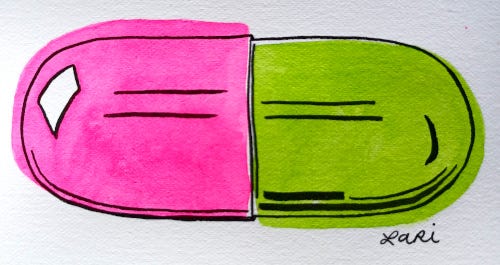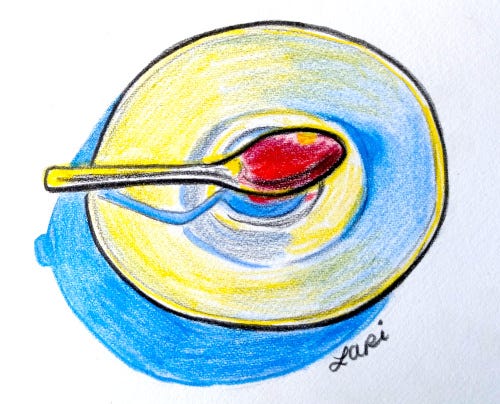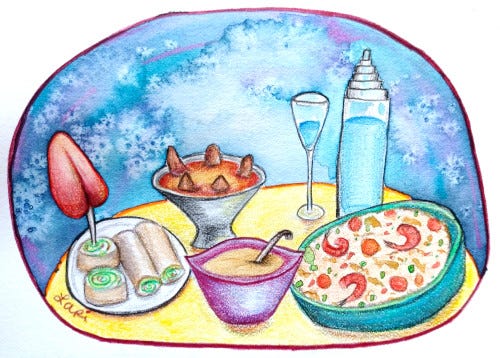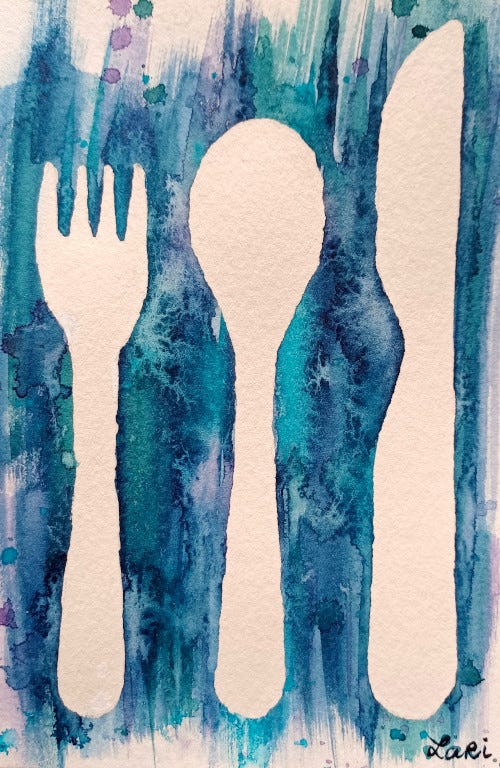RENDERED 15: Imaginary Food, Part II
Futuristic food in the collective imagination, from Soylent Green to Star Trek
Welcome back to RENDERED! This month's essay is a continuation of my thoughts on imaginary food. I came up with 4 categories of imaginary food: the first two, whimsical and mystical/legendary foods were covered in the TIDBITS narrated essay (for paid subscribers) on March 1. Today, I'm getting into the futuristic: the dystopian, and the alien. Enjoy the essay, and if you're interested in more content, please consider a paid subscription. Without further ado, let's get into it!
What do imaginary future foods reveal about our hopes and fears about the human species, and our capacity to survive? Imagining potential foods of the future shows us where we can allow ourselves to imagine going... or where we're afraid we'll end up. Creating imaginary food requires us first to define "food." In the broadest sense, food is (of course) sustenance for survival... but humans also often understand food to be a symbolic aspect of culture. If we then question and subvert it into something still recognizable, but emblematic of a potential future, we're looking at some interesting creations.

Thinking about the future leaves room for mixed feelings: hopeful, anxious, afraid, aspirational... Imagining how we'll be eating in 50, 100, 300 years tells us a lot about how we view our current food systems, and how we imagine future humans will treat our planet and its resources. It's also a reflection of how much faith we have in humanity to get its shit together.
A comic strip called "Our New Age," written by South African-American Professor Athelstan Spilhaus, ran from 1958-1973. It imagined what the future would look like, in a way to make science fun and accessible for kids. Among ideas like the greenhouse effect, e-mail and internet, it anticipated food shortages and world hunger, and a 1965 strip predicted that synthetic food would be the solution... Is it, though? Protein from vegetables had already been isolated in a lab 35 years prior, in 1930, and the first patent for an "isolated soybean protein" dates to 1940. And humanity is still, in 2022, running headfirst into the brick wall of irreversible climate change and associated food insecurity and water shortages.
Imagining the future of food, I propose we dive into the world of science fiction.

Soylent Green is a 1973 film based on a novel called Make Room! Make Room! by Harry Harrison. The movie takes place in the year 2022. It imagines a dismal New York City, severely overpopulated and polluted, rife with social unrest, food shortages, water rationing, and the only affordable food being wafers produced by the Soylent Corporation.
Soylent Green is a wafer-like food product that is manufactured from sea plankton... or is it? Soylent Green shortages cause riots in the streets, and those disruptors are scooped up and hauled away in garbage trucks with hydraulic lifts, giving you an idea of the value of human life.
The dramatic finale reveals (sorry for the spoiler, but come on... it's a 50-year-old movie) that Soylent Green is made from people: the bodies of the poor, the sick, those who have chosen to undergo state-sponsored euthanasia, are processed into Soylent Green wafers. A distraught Charlton Heston shouts this horrifying discovery out to the crowd of onlookers at the end of the film: "Soylent Green is PEOPLE!" An iconic cinematic moment.
Haunting, as we realize that this desperate declaration will do nothing, and this ugly world will continue to run its course. Which is worse: that we have damaged our planet beyond repair and have resorted to consuming our own? Or the indifference of the people in the crowd, the doomed feeling of helplessness? You know that this revelation is proclaimed to those who are helpless themselves, and subject to the corrupted, wretched system that feeds them.
It's hard to ignore the similarities between our world today, our 2022, and the 2022 pictured in the film.
The United Nations Intergovernmental Panel on Climate Change (IPCC) report tells us that things are really bad. So bad, as the UN Secretary-General tells us, that humanity is being "clobbered"--that some ecosystems are "at the point of no return." Unfortunately, those effects of climate change are first felt, and ultimately more severely, by those who had almost no hand in creating it. But then again, that's just our food system working as it was designed to--not in the interest of human health or respect for our environment, but for profit.
Surprisingly (or not), there is actually a company called Soylent. Silicon Valley investors leapt to sink money into this food venture back in 2013, which produces meal-replacement drinks, powders and bars. The inventor wanted to create a food item with "all the nutrition and none of the hassle of food." (I'm clutching my pearls at the thought--quelle horreur!)
At its heart, Soylent Green was supposed to be made from plankton... but another water organism, algae, may indeed have promise, according to journalist Larissa Zimberoff in her book, Technically Food. Algae is a source of fuel, nutrients, and protein, for humans and livestock alike. Preliminary study results out of UC Davis show that adding seaweed (aka. macroalgae) to cows' diets drastically decreases their methane output... but algae alone can't do the job.
But what of giant multinationals (or rather, corporate overlords), like the fictional Soylent Corporation?
Hey, inventing the Next Big Thing in techmeat/meal replacement takes time and cash. Who's got the money to invest in those startups that make big promises? More often than not, the cash comes from Silicon Valley. Silicon Valley investors seek to put money into techmeat projects with unique fabrication techniques (gotta get those precious patents!), rather than what is truly sustainable, ethical to animals, and healthy for us.
Most of these techfood startups require beaucoup bucks upfront to develop their proprietary process... which often include extracts and extruded compounds, genetically modified and fractionated molecules, and heavy reliance on coconut and palm oils... All for an end product that ultimately cannot be scaled up to feed large populations, and certainly not for an affordable price to the consumer. In other words (specifically, those of food writer Alicia Kennedy echo in my brain), techmeat will not save the world.
Let's look beyond the hackneyed concept of techmeat. For funsies, I want to look at futuristic alien food.

Of course, I can't talk sci-fi without talking about (my beloved) Star Trek! Star Trek, for those who don't know, is a science-fiction franchise that began on TV in the United States in the 1960's. It depicts a future in which humans have gotten their shit together on Earth and eradicated sickness, hunger, and poverty.
In this essay, I want to focus on Star Trek: Deep Space Nine (aired 1993-1999), which I think is one of the greatest shows ever made (and you'll never convince me otherwise). It discusses humanity's political and ethical dilemmas through the lens of an epic space opera--it's a beautiful metaphor for the complexity and fragility of the human experience, and the show prominently featured people of color and women in leading roles.
Captain Sisko (portrayed in stellar form by Avery Brooks) not only gives a portrayal of Black fatherhood that was ahead of its time, but is also an accomplished cook, using food as both celebration and food for the soul. Captain Sisko prepares various Earth foods throughout the show, including Creole dishes from his native New Orleans--showing us that gastronomic cultural heritage is alive and well in the 24th century. As a cross-cultural ambassador, he also prepares dishes with non-Earth native ingredients and Creole seasonings.
In the 24th century, humans now sail among the stars, coexisting with some alien species, and creating conflict with others. Food on spaceships is produced in devices called "replicators" (which can synthesize any food or drink from the molecular level) or grown onboard in hydroponic gardens. People enjoy cuisines from planets all over the galaxy, and eat a stunning array of otherworldly ingredients.

If we understand (or expect) food to be representative of its culture of origin, we can understand "aliens" in a deeper sense, based on what they eat. For example:
Klingons, a battle-ready culture of warriors, eat foods that echo the viscerality of their society: blood pie, bloodwine, gagh (wriggling live worms), and aggressive coffee called raktajino.
Vulcans, an ascetic species of vegetarian telepaths, specialize in plomeek soup, a bland vegetable broth. Vulcan cuisine has muted flavors, appropriate for a species that keeps all strong emotions in check and relies on logic. Plomeek soup was fed to Spock during his pon farr (a mating period where the men go into "heat," and speaking about it is taboo)--this makes me think of cornflakes, and their invention to quell bodily excitation, to attain spiritual and religious purity.
Romulan ale, of superior quality and potency, is an off-limits temptation. The sky-blue alcohol in strange decanters is hard to come by because of a trade embargo with the Romulan Empire (akin to Cuban cigars).
Bajoran cuisine, from a newly-emancipated planet that had seen military occupation, is an intensely-flavored, rustic and robust cuisine from a culture of people who had fought in resistance movements and faced subjugation under a ruthless expansionist regime. (Sound familiar?)
Earth food is the baseline for cuisine in Star Trek, the constant frame of reference. Why? Of course, the viewer can connect more easily with Earth food. But also: in order to imagine something alien, something that embodies what I call "familiar-foreignness," you have to use a common frame of reference, then subvert it.
Another way to look at it is a bit darker: perhaps it's symbolic of humankind's tendency to establish itself in a hegemonic relationship towards others. Even if humans have succeeded in eradicating society's ills on their own planet, they have appointed themselves, and Earth, as the center of the universe: The United Federation of Planets is headquartered on Earth.
Humans are skilled at creating the veneer of civilization, but that civility is precarious. So says the Deep Space Nine bartender, Quark, in his critique of "hoo-mans":
"They're a wonderful, friendly people, as long as their bellies are full and their holosuites are working. But take away their creature comforts, deprive them of food, sleep, sonic showers, put their lives in jeopardy over an extended period of time, and those same friendly, intelligent, wonderful people... will become as nasty and as violent as the most bloodthirsty Klingon."

What will we be eating in the future? Will we even survive as a species in the future? What will be part of our collective food memory, and what will be forgotten?
I think we can agree it would be nicer if our future looked more like Star Trek and less like Soylent Green. But how do we get there? The last chapter of Larissa Zimberoff's book Technically Food asks prominent voices in the food space what we'll be eating in 20 years. One thing that's for sure, is that we cannot continue with the same system we're currently in.
Chef Sean Sherman, founder of the Sioux Chef, emphasizes the hope for a community-based food system which moves away from overreliance on animal products, features whole foods, respects Indigenous knowledge of regional ecology, and is accessible to all.
Chapter 5 of the UN IPCC report discusses food systems, and includes multiple recommendations, such as: encouraging crop diversity and seed sovereignty, and improving the conditions of women, who play a pivotal role in food systems and ensuring food security.
Science fiction can show us a dismal portrait of our potential to cause irreparable harm, or give an aspirational picture of humanity--one in which we have not only survived, but figured out how to make our global society and our food systems equitable for all.
I'd sure love to imagine my future descendants, zipping around the galaxy in starships. Perhaps they'll tell stories about their eccentric 12th great-auntie who was an artist back in the Dark Ages, who used ancient technology to record her ideas and recipes, and to tell even older stories about food... maybe they'll even do recipe swaps with their interstellar neighbors for some far-out potlucks.
Hey, a girl can dream, can't she?
If you enjoy my work and would like to support my efforts, share with a friend/hit the "like"/leave a comment to help this newsletter grow, visit my web store, or consider a paid subscription for yourself or a friend. I also accept one-time donations via my website. To follow my art practice, catch me on Instagram or view my portfolio on my website. Be well, take care of your heart, and I'll see you all next month.
Bibliography
Barclay, Eliza. "Soylent: An Offbeat Food Idea Investors Are Taking Seriously." NPR, 30 Oct 2013.
Bass, George. "In 1973, ‘Soylent Green’ envisioned the world in 2022. It got a lot right." The Washington Post, 9 Jan 2022.
Bastién, Angelica Jade. "Deep Space Nine Is TV's Most Revolutionary Depiction of Black Fatherhood." Vulture, 19 Jan 2018.
Decherney, Peter. “Race in Space.” Cinéaste, vol. 26, no. 3, Cineaste Publishers, Inc, 2001, pp. 38–39, http://www.jstor.org/stable/41689367.
Holtzman, Jon D. “Food and Memory.” Annual Review of Anthropology, vol. 35, Annual Reviews, 2006, pp. 361–78, http://www.jstor.org/stable/25064929.
Kennedy, Alicia. "On the Future." From the Desk of Alicia Kennedy, 22 Feb 2021.
Kraker, Dan. "How a far-sighted Minnesota scientist pointed America toward the future." Minnesota Public Radio News, 14 Oct 2016.
Novak, Matt. "Meal-in-a-pill : A staple of science fiction." BBC, 18 Nov 2014.
Phillips, Ethan and William J. Birnes. Star Trek Cookbook. Pocket Books, 1999. p.153-6, 179.
"Space-Food History (Star Trek Lore)." Youtube, uploaded by Certifiably Ingame. 15 Mar 2019.
Troitino, Christina. "Is Meal Replacement Startup Soylent Down To Its Last Drop?" Forbes, 18 Feb 2020.
"What The Latest UN Climate Report Says About Our Future." 1A Podcast, NPR. 10 Mar 2022.
Zimberoff, Larissa. Technically Food: Inside Silicon Valley's Mission to Change What We Eat. Abrams Press, 2021. p. 9, 21, 24-5, 46-7, 57, 212-3.


